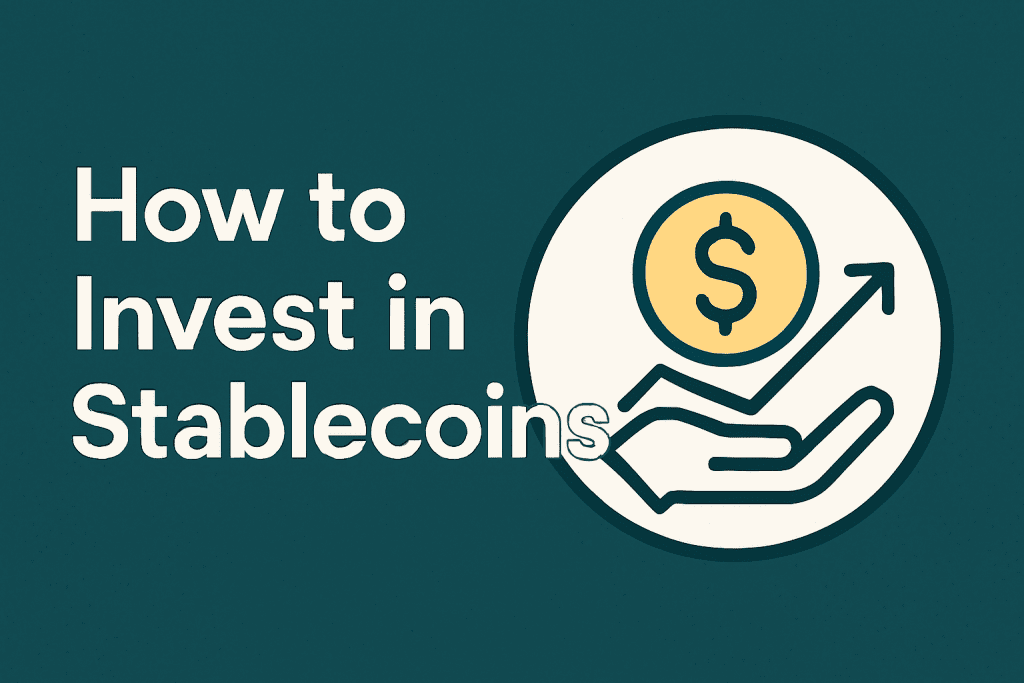Stablecoins have emerged as a vital asset class in the crypto economy.
As the crypto world expands beyond volatile tokens like Bitcoin and Ethereum, many investors are turning to stablecoins for stability, liquidity, and yield generation.
This guide dives deep into how to invest in stablecoins effectively, what to consider, and where they fit in a modern digital portfolio.
Key Takeaways
- Stablecoins offer price stability, making them ideal for preserving capital during volatile market conditions.
- Multiple investment options include lending, staking, and liquidity mining for earning passive income.
- Top stablecoins to consider are USDC, USDT, DAI, and newer entrants like PYUSD and RLUSD.
- Security and transparency are key factors, choose platforms and stablecoins with strong audit and compliance frameworks.
- Regulatory developments in the U.S., EU, and Asia are shaping the future of stablecoin investments.
What Are Stablecoins?
Stablecoins are cryptocurrencies pegged to the value of traditional assets such as fiat currencies (e.g., USD, EUR), commodities (e.g., gold), or other digital assets.
Unlike Bitcoin, which is highly volatile, stablecoins aim to maintain a consistent value.
This predictability makes them ideal for daily transactions, cross-border payments, and yes, investment.
There are four primary types of stablecoins:
- Fiat-Collateralized: Backed 1:1 by fiat currency in a bank (e.g., USDC, USDT).
- Crypto-Collateralized: Backed by other cryptocurrencies, usually overcollateralized (e.g., DAI).
- Algorithmic: Use algorithms and smart contracts to maintain peg (e.g., Frax).
- Commodity-Collateralized: Backed by assets like gold (e.g., PAXG), making them commodity-backed forms of stablecoins.
Why Invest in Stablecoins?
Many investors ask, “Why invest in stablecoins if they don’t appreciate like Bitcoin?”.
The answer lies in their use cases and income potential.
Here’s what makes stablecoins a valuable addition to any portfolio:
- Price Stability: Their pegged nature offers a safe haven during market turbulence.
- High Liquidity: Easily tradable on most exchanges and compatible with DeFi apps.
- Yield Generation: Lend them or stake them to earn interest.
- Hedge Against Volatility: Preserve portfolio value in bear markets.
- Cross-border Utility: Ideal for international investments and remittances.
In 2023 alone, stablecoins processed over $7 trillion in transaction volume, exceeding even Visa’s global payment throughput.
This data proves their relevance not just as utility tokens but also as income-generating assets.
How to Invest in Stablecoins: Step-by-Step
Let’s break down the exact steps to get started with stablecoin investing in 2025.
1. Choose a Reputable Exchange or Platform
Begin by selecting a trustworthy cryptocurrency exchange or DeFi platform.
Your choice should be based on factors like security, user interface, supported stablecoins, trading fees, and customer support.
Top centralized platforms include:
- Coinbase – Known for its regulatory compliance and beginner-friendly interface.
- Binance – Offers a wide selection of stablecoins and low trading fees.
- Kraken – Offers robust security features and a range of fiat funding options.
If you prefer decentralized finance (DeFi), explore:
- Uniswap – A leading DEX with access to a variety of stablecoin pairs.
- Curve Finance – Optimized for stablecoin swaps with minimal slippage.
- Aave – A lending protocol that allows users to earn interest or borrow using stablecoins as collateral.
Make sure to research each platform’s reputation and user reviews before depositing funds.
2. Create and Verify Your Account
Most exchanges require Know Your Customer (KYC) verification to comply with global regulatory standards and prevent financial crime.
This process typically involves submitting a government-issued ID, proof of residence, and in some cases, a selfie for biometric verification.
Verification usually takes anywhere from a few minutes to 48 hours, depending on the platform and volume of requests.
Completing this step is essential to unlock full access to trading, deposits, withdrawals, and staking options.
3. Deposit Funds
You can invest using fiat currency (e.g., U.S. dollar, EUR), bitcoin, or other cryptocurrencies (e.g., ETH).
Most platforms support bank transfers, credit/debit card payments, and crypto deposits.
Choose a funding method that suits your needs and be aware of any associated fees or processing times.
Once your funds are in your platform wallet, you’re ready to purchase stablecoins.sing fiat currency (e.g., USD, EUR) or other cryptocurrencies (e.g., BTC, ETH).
Deposit your funds into the platform wallet.
4. Buy the Stablecoin
Select the stablecoin, such as USD Coin, that best fits your goals and risk profile.
Consider how and where you plan to use or invest it:
- USDC – Transparent, regulated, and ideal for DeFi platforms, backed by monthly audits and supported by Coinbase and Circle.
- USDT – The most widely used stablecoin with high liquidity across global exchanges, though less transparent than USDC and includes tether among its foundational stablecoins.
- DAI – Fully decentralized and backed by crypto collateral, making it a preferred choice for DeFi enthusiasts who prioritize censorship resistance.
- PAXG – Pegged to physical gold, useful for those looking to combine the benefits of blockchain with a traditional store of value.
Newer options like PYUSD (PayPal), RLUSD (Ripple Labs), and LUSD (Lava Protocol) offer niche benefits such as integration with specific ecosystems or enhanced decentralization features.
Evaluate each coin’s issuer, transparency, and ecosystem compatibility before buying.
5. Store Your Stablecoins Securely
For long-term holding, use a secure crypto wallet to protect your digital assets from hacks, loss of access, or exchange failures.
- Hot Wallets: MetaMask, Trust Wallet – These are internet-connected wallets ideal for users who actively interact with DeFi apps or trade frequently.
While convenient, they are more susceptible to online threats.
- Cold Wallets: Ledger, Trezor – These hardware wallets store your private keys offline, offering maximum security for long-term investors who prioritize safety over convenience.
Always enable two-factor authentication (2FA) and consider using a backup recovery phrase stored in a safe location.
Ways to Earn Yield on Stablecoins
One of the most attractive features of stablecoins is their ability to generate passive income.
Here’s how to invest in stablecoins for yield:
1. Lending Platforms
Lending stablecoins is one of the most straightforward ways to generate passive income in the crypto space.
Centralized platforms:
- Nexo – Offers daily interest payouts and asset insurance, making it appealing to conservative investors.
- BlockFi (pending regulatory changes) – Known for its ease of use and fiat onboarding, though its future remains uncertain due to legal challenges.
Decentralized options:
- Aave – A leading DeFi lending protocol where users can supply stablecoins to earn variable interest rates.
- Compound – Another major protocol offering algorithmically adjusted interest rates based on supply and demand.
These platforms offer annual interest rates ranging from 5% to 10%, depending on market conditions and platform risk.
Always assess the security and reputation of the platform before depositing your funds.
2. Liquidity Mining
Provide liquidity to decentralized exchanges like Uniswap, Curve, or SushiSwap by depositing pairs of assets, typically including a stablecoin.
In return, you earn a portion of the trading fees and may receive additional incentives in the form of native tokens.
While this can generate attractive returns, it also carries risks such as impermanent loss, when the value of your deposited assets changes relative to one another.
It’s best suited for users who understand DeFi mechanics and are comfortable with smart contract risks.
3. Yield-Bearing Stablecoins
New stablecoins like sUSDS, Staked USDe, and YBX offer built-in interest through staking mechanisms, allowing users to earn rewards simply by holding or locking their tokens in specific smart contracts.
These stablecoins typically integrate with DeFi protocols to offer automated yield opportunities.
While they offer convenience and competitive returns, investors should evaluate the sustainability of the yield models and any associated smart contract risks.
These are best suited for experienced DeFi users comfortable navigating decentralized platforms.
Key Considerations Before Investing
Transparency
Look for stablecoins with regular third-party audits and on-chain proof of reserves.
USDC, for example, publishes monthly reports.
Transparency is crucial for maintaining user trust and ensuring that each token is adequately backed by real-world assets.
Regulation
Stablecoins are under increasing regulatory and algorithmic scrutiny.
The U.S. is considering the Stablecoin TRUST Act, and the EU’s MiCA framework is setting standards for issuers.
These regulations aim to enhance consumer protection and market stability.
Investors should stay updated, as new laws could affect how stablecoins are issued, used, or taxed.
Centralization vs. Decentralization
USDT and USDC are centralized and may face government intervention.
DAI and LUSD are decentralized, offering more censorship resistance.
Centralized stablecoins are often easier to regulate and integrate with traditional finance, while decentralized options prioritize user sovereignty and on-chain governance.
Peg Stability
Research past de-pegging events (e.g., TerraUSD collapse) to assess risk.
Stablecoins with strong collateral frameworks (like USDC or DAI) tend to weather volatility better.
Monitoring a coin’s market behavior and redemption mechanisms during high-stress periods can provide insight into its ability to maintain its peg.
Who Should Invest in Stablecoins?
- Conservative Crypto Investors: Seeking lower-risk, yield-bearing assets.
- Active Traders: Using stablecoins to move in/out of positions during volatility.
- Global Workers: Paid in USDT or USDC for cross-border transactions.
- Institutions: Exploring embedded finance and stable yield mechanisms.
Future Outlook for Stablecoin Investments
With rising global adoption, especially in emerging markets, stablecoins are expected to gain traction as investment-grade digital assets.
Initiatives like Fidelity’s pilot stablecoin and PayPal’s PYUSD are bringing institutional legitimacy to the space.
Interoperability improvements and integration with blockchain-based CBDCs may also open new avenues for yield and portfolio diversification.
Final Thoughts
If you’re wondering how to invest in stablecoins in 2025, the process is easier and more lucrative than ever.
Whether you’re looking for price stability, passive income, or global financial access, stablecoins offer a unique proposition.
Start by choosing the right platform, select a trusted stablecoin, and put your digital dollars to work through lending, staking, or liquidity mining.
With the right strategy, stablecoins can be a cornerstone of your crypto investment portfolio.
Stay informed, diversify wisely, and use the power of stability in a volatile digital world.
Read Next:
- What Is a Stablecoin?
- What is the Purpose of Stablecoins?
- The Benefits of Stablecoins
- Best Stablecoins in 2025
FAQ
1. What is the best way to earn interest on stablecoins?
You can earn interest by lending stablecoins on DeFi platforms like Aave and Compound or through centralized providers like Nexo.
Average annual yields range from 5–10%.
2. Are stablecoins safe investments?
Stablecoins are generally more stable than other cryptocurrencies, but they still carry risks such as regulatory changes, platform vulnerabilities, or de-pegging events common in the broader cryptocurrency market.
Choose assets with strong collateral and transparency.
3. Can I lose money investing in stablecoins?
Yes.
Although they’re designed for stability, you can lose funds due to smart contract bugs, exchange hacks, or the collapse of algorithmic stablecoins like TerraUSD.
4. Which stablecoin is best for DeFi?
DAI and USDC are the most widely used in DeFi protocols due to their reliability, decentralization (in DAI’s case), and strong audit trails.
5. How much should I allocate to stablecoins in my portfolio?
This depends on your risk tolerance.
Conservative investors might hold 30–50% in stablecoins for income and stability, while aggressive investors use them primarily for liquidity between trades.

